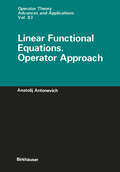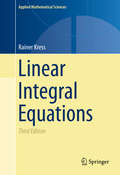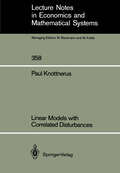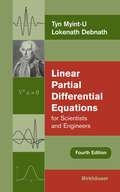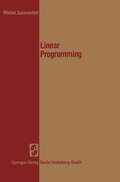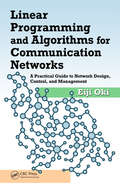- Table View
- List View
Linear Functional Equations. Operator Approach (Operator Theory: Advances and Applications #83)
by Anatolij AntonevichIn this book we shall study linear functional equations of the form m bu(x) == Lak(X)U(Qk(X)) = f(x), (1) k=l where U is an unknown function from a given space F(X) of functions on a set X, Qk: X -+ X are given mappings, ak and f are given functions. Our approach is based on the investigation of the operators given by the left-hand side of equa tion (1). In what follows such operators will be called functional operators. We will pay special attention to the spectral properties of functional operators, first of all, to invertibility and the Noether property. Since the set X, the space F(X), the mappings Qk and the coefficients ak are arbitrary, the class of operators of the form (1) is very rich and some of its individ ual representatives are related with problems arising in various areas of mathemat ics and its applications. In addition to the classical theory of functional equations, among such areas one can indicate the theory of functional-differential equations with deviating argument, the theory of nonlocal problems for partial differential equations, the theory of boundary value problems for the equation of a vibrating string and equations of mixed type, a number of problems of the general theory of operator algebras and the theory of dynamical systems, the spectral theory of au tomorphisms of Banach algebras, and other problems.
Linear-implizite Runge-Kutta-Methoden und ihre Anwendung (Teubner-Texte zur Mathematik #127)
by Rüdiger WeinerLinear Induction Accelerators for High-Power Microwave Devices
by Igor VintizenkoLinear induction accelerators are successfully used as power supplies for numerous devices of relativistic high-frequency electronics. This book addresses ways to solve physical and engineering problems arising in the calculation, design, modeling and operation of linear induction accelerators intended for supplying relativistic microwave devices. It reviews and analyzes both classic and recent studies on the topic of linear induction accelerators (LIA) for generating and amplifying microwave radiation by relativistic devices.
Linear Induction Accelerators for High-Power Microwave Devices
by Igor VintizenkoLinear induction accelerators are successfully used as power supplies for numerous devices of relativistic high-frequency electronics. This book addresses ways to solve physical and engineering problems arising in the calculation, design, modeling and operation of linear induction accelerators intended for supplying relativistic microwave devices. It reviews and analyzes both classic and recent studies on the topic of linear induction accelerators (LIA) for generating and amplifying microwave radiation by relativistic devices.
Linear Integral Equations (Applied Mathematical Sciences #82)
by Rainer KressThis book combines theory, applications, and numerical methods, and covers each of these fields with the same weight. In order to make the book accessible to mathematicians, physicists, and engineers alike, the author has made it as self-contained as possible, requiring only a solid foundation in differential and integral calculus. The functional analysis which is necessary for an adequate treatment of the theory and the numerical solution of integral equations is developed within the book itself. Problems are included at the end of each chapter. For this third edition in order to make the introduction to the basic functional analytic tools more complete the Hahn–Banach extension theorem and the Banach open mapping theorem are now included in the text. The treatment of boundary value problems in potential theory has been extended by a more complete discussion of integral equations of the first kind in the classical Holder space setting and of both integral equations of the first and second kind in the contemporary Sobolev space setting. In the numerical solution part of the book, the author included a new collocation method for two-dimensional hypersingular boundary integral equations and a collocation method for the three-dimensional Lippmann-Schwinger equation. The final chapter of the book on inverse boundary value problems for the Laplace equation has been largely rewritten with special attention to the trilogy of decomposition, iterative and sampling methodsReviews of earlier editions:"This book is an excellent introductory text for students, scientists, and engineers who want to learn the basic theory of linear integral equations and their numerical solution."(Math. Reviews, 2000)"This is a good introductory text book on linear integral equations. It contains almost all the topics necessary for a student. The presentation of the subject matter is lucid, clear and in the proper modern framework without being too abstract." (ZbMath, 1999)
Linear Models for the Prediction of the Genetic Merit of Animals
by Raphael A Mrode Ivan PocrnicFundamental to any livestock improvement programme by animal scientists, is the prediction of genetic merit in the offspring generation for desirable production traits such as increased growth rate, or superior meat, milk and wool production. Covering the foundational principles on the application of linear models for the prediction of genetic merit in livestock, this new edition is fully updated to incorporate recent advances in genomic prediction approaches, genomic models for multi-breed and crossbred performance, dominance and epistasis. It provides models for the analysis of main production traits as well as functional traits and includes numerous worked examples. For the first time, R codes for key examples in the textbook are provided online. The book covers: - The relationship between the genome and the phenotype. - BLUP models for various livestock data and structure. - Incorporation of related ancestral parents and metafounders in prediction models. - Models for survival analysis and social interaction. - Advancements in genomic prediction approaches and selection. - Genomic models for multi-breed and crossbred performance. - Models for non-additive genetic effects including dominance and epistasis. - Estimation of genetic parameters including Gibbs sampling approaches. - Computation methods for solving linear mixed model equations. Suitable for graduate and postgraduate students, researchers and lecturers of animal breeding, genetics and genomics, this established textbook provides a thorough grounding in both the basics and in new developments of linear models and animal genetics.
Linear Models in the Mathematics of Uncertainty (Studies in Computational Intelligence)
by Carol Jones Mark J Wierman Terry D Clark Alex Pham Michael A. RedmondThe purpose of this book is to present new mathematical techniques for modeling global issues. These mathematical techniques are used to determine linear equations between a dependent variable and one or more independent variables in cases where standard techniques such as linear regression are not suitable. In this book, we examine cases where the number of data points issmall (effects of nuclear warfare), where the experiment is not repeatable (the breakup of the former Soviet Union), and where the data is derived from expert opinion (how conservative is a political party). In all these cases the data is difficult to measure and an assumption of randomness and/or statistical validity is questionable. We apply our methods to real world issues in international relations such as nuclear deterrence, smart power, and cooperative threat reduction. We next apply our methods to issues in comparative politics such as successful democratization, quality of life, economic freedom, political stability, and failed states. Finally, issues involving deaf and hard of hearing children are explored.
Linear Models with Correlated Disturbances (Lecture Notes in Economics and Mathematical Systems #358)
by Paul KnottnerusIn each chapter of this volume some specific topics in the econometric analysis of time series data are studied. All topics have in common the statistical inference in linear models with correlated disturbances. The main aim of the study is to give a survey of new and old estimation techniques for regression models with disturbances that follow an autoregressive-moving average process. In the final chapter also several test strategies for discriminating between various types of autocorrelation are discussed. In nearly all chapters it is demonstrated how useful the simple geometric interpretation of the well-known ordinary least squares (OLS) method is. By applying these geometric concepts to linear spaces spanned by scalar stochastic variables, it emerges that well-known as well as new results can be derived in a simple geometric manner, sometimes without the limiting restrictions of the usual derivations, e. g. , the conditional normal distribution, the Kalman filter equations and the Cramer-Rao inequality. The outline of the book is as follows. In Chapter 2 attention is paid to a generalization of the well-known first order autocorrelation transformation of a linear regression model with disturbances that follow a first order Markov scheme. Firstly, the appropriate lower triangular transformation matrix is derived for the case that the disturbances follow a moving average process of order q (MA(q». It turns out that the calculations can be carried out either analytically or in a recursive manner.
Linear Multivariable Control Engineering Using GNU Octave
by Wolfgang BorutzkyThis textbook presents an in-depth introductory survey of several fundamental advanced control concepts and techniques all ranging from modern ideas. The book emphasizes ideas, an understanding of key concepts, methodologies, and results. In line with this, the book addresses master’s students in the overlap of engineering and computer science as well as engineers working in various application fields and interested in useful control techniques and less in system theories appealing from a mathematical point of view. The book aims to show what methods and results learned for single-variable systems are also applicable to multivariable systems, what is different and why. The structured text covers a broad spectrum of topics from decentralized control to the use of linear matrix inequalities (LMIs). Methods and results are illustrated by many examples and using free, open source mathematical software, predominately GNU Octave. In some cases, the free mathematical software package Scilab is also used. The book features exercises and examples throughout.
Linear Optimization and Duality: A Modern Exposition
by Craig A. ToveyLinear Optimization and Dualiyy: A Modern Exposition departs from convention in significant ways. Standard linear programming textbooks present the material in the order in which it was discovered. Duality is treated as a difficult add-on after coverage of formulation, the simplex method, and polyhedral theory. Students end up without knowing duality in their bones. This text brings in duality in Chapter 1 and carries duality all the way through the exposition. Chapter 1 gives a general definition of duality that shows the dual aspects of a matrix as a column of rows and a row of columns. The proof of weak duality in Chapter 2 is shown via the Lagrangian, which relies on matrix duality. The first three LP formulation examples in Chapter 3 are classic primal-dual pairs including the diet problem and 2-person zero sum games. For many engineering students, optimization is their first immersion in rigorous mathematics. Conventional texts assume a level of mathematical sophistication they don’t have. This text embeds dozens of reading tips and hundreds of answered questions to guide such students. Features Emphasis on duality throughout Practical tips for modeling and computation Coverage of computational complexity and data structures Exercises and problems based on the learning theory concept of the zone of proximal development Guidance for the mathematically unsophisticated reader About the Author Craig A. Tovey is a professor in the H. Milton Stewart School of Industrial and Systems Engineering at Georgia Institute of Technology. Dr. Tovey received an AB from Harvard College, an MS in computer science and a PhD in operations research from Stanford University. His principal activities are in operations research and its interdisciplinary applications. He received a Presidential Young Investigator Award and the Jacob Wolfowitz Prize for research in heuristics. He was named an Institute Fellow at Georgia Tech, and was recognized by the ACM Special Interest Group on Electronic Commerce with the Test of Time Award. Dr. Tovey received the 2016 Golden Goose Award for his research on bee foraging behavior leading to the development of the Honey Bee Algorithm.
Linear Optimization and Duality: A Modern Exposition
by Craig A. ToveyLinear Optimization and Dualiyy: A Modern Exposition departs from convention in significant ways. Standard linear programming textbooks present the material in the order in which it was discovered. Duality is treated as a difficult add-on after coverage of formulation, the simplex method, and polyhedral theory. Students end up without knowing duality in their bones. This text brings in duality in Chapter 1 and carries duality all the way through the exposition. Chapter 1 gives a general definition of duality that shows the dual aspects of a matrix as a column of rows and a row of columns. The proof of weak duality in Chapter 2 is shown via the Lagrangian, which relies on matrix duality. The first three LP formulation examples in Chapter 3 are classic primal-dual pairs including the diet problem and 2-person zero sum games. For many engineering students, optimization is their first immersion in rigorous mathematics. Conventional texts assume a level of mathematical sophistication they don’t have. This text embeds dozens of reading tips and hundreds of answered questions to guide such students. Features Emphasis on duality throughout Practical tips for modeling and computation Coverage of computational complexity and data structures Exercises and problems based on the learning theory concept of the zone of proximal development Guidance for the mathematically unsophisticated reader About the Author Craig A. Tovey is a professor in the H. Milton Stewart School of Industrial and Systems Engineering at Georgia Institute of Technology. Dr. Tovey received an AB from Harvard College, an MS in computer science and a PhD in operations research from Stanford University. His principal activities are in operations research and its interdisciplinary applications. He received a Presidential Young Investigator Award and the Jacob Wolfowitz Prize for research in heuristics. He was named an Institute Fellow at Georgia Tech, and was recognized by the ACM Special Interest Group on Electronic Commerce with the Test of Time Award. Dr. Tovey received the 2016 Golden Goose Award for his research on bee foraging behavior leading to the development of the Honey Bee Algorithm.
Linear Parameter-Varying and Time-Delay Systems: Analysis, Observation, Filtering & Control (Advances in Delays and Dynamics #3)
by Corentin BriatThis book provides an introduction to the analysis and control of Linear Parameter-Varying Systems and Time-Delay Systems and their interactions. The purpose is to give the readers some fundamental theoretical background on these topics and to give more insights on the possible applications of these theories. This self-contained monograph is written in an accessible way for readers ranging from undergraduate/PhD students to engineers and researchers willing to know more about the fields of time-delay systems, parameter-varying systems, robust analysis, robust control, gain-scheduling techniques in the LPV fashion and LMI based approaches. The only prerequisites are basic knowledge in linear algebra, ordinary differential equations and (linear) dynamical systems. Most of the results are proved unless the proof is too complex or not necessary for a good understanding of the results. In the latter cases, suitable references are systematically provided. The first part pertains on the representation, analysis and control of LPV systems along with a reminder on robust analysis and control techniques. The second part is concerned with the representation and analysis of time-delay systems using various time-domain techniques. The third and last part is devoted to the representation, analysis, observation, filtering and control of LPV time-delay systems. The book also presents many important basic and advanced results on the manipulation of LMIs.
Linear Parameter-Varying Control for Engineering Applications (SpringerBriefs in Electrical and Computer Engineering)
by Andrew P. White Guoming Zhu Jongeun ChoiThe subject of this brief is the application of linear parameter-varying (LPV) control to a class of dynamic systems to provide a systematic synthesis of gain-scheduling controllers with guaranteed stability and performance. An important step in LPV control design, which is not well covered in the present literature, is the selection of weighting functions. The proper selection of weighting functions tunes the controller to obtain the desired closed-loop response. The selection of appropriate weighting functions is difficult and sometimes appears arbitrary. In this brief, gain-scheduling control with engineering applications is covered in detail, including the LPV modeling, the control problem formulation, and the weighting function optimization. In addition, an iterative algorithm for obtaining optimal output weighting functions with respect to the H2 norm bound is presented in this brief. Using this algorithm, the selection of appropriate weighting functions becomes an automatic process. The LPV design and control synthesis procedures in this brief are illustrated using: • air-to-fuel ratio control for port-fuel-injection engines; • variable valve timing control; and • application to a vibration control problem. After reading this brief, the reader will be able to apply its concepts to design gain-scheduling controllers for their own engineering applications. This brief provides detailed step-by-step LPV modeling and control design strategies along with an automatic weight-selection algorithm so that engineers can apply state-of-the-art LPV control synthesis to solve their own engineering problems. In addition, this brief should serve as a bridge between the H-infinity and H2 control theory and the real-world application of gain-scheduling control.
Linear Partial Differential Equations for Scientists and Engineers
by Tyn Myint-U Lokenath DebnathThis significantly expanded fourth edition is designed as an introduction to the theory and applications of linear PDEs. The authors provide fundamental concepts, underlying principles, a wide range of applications, and various methods of solutions to PDEs. In addition to essential standard material on the subject, the book contains new material that is not usually covered in similar texts and reference books. It also contains a large number of worked examples and exercises dealing with problems in fluid mechanics, gas dynamics, optics, plasma physics, elasticity, biology, and chemistry; solutions are provided.
Linear Piezoelectric Plate Vibrations: Elements of the Linear Theory of Piezoelectricity and the Vibrations Piezoelectric Plates
by Henry Frank TierstenLinear Position Sensors: Theory and Application
by David S. Nyce* Sensor technology is an increasingly important area of research * This will be the only book entirely devoted to the topic
Linear Prediction Theory: A Mathematical Basis for Adaptive Systems (Springer Series in Information Sciences #21)
by Peter StrobachLnear prediction theory and the related algorithms have matured to the point where they now form an integral part of many real-world adaptive systems. When it is necessary to extract information from a random process, we are frequently faced with the problem of analyzing and solving special systems of linear equations. In the general case these systems are overdetermined and may be characterized by additional properties, such as update and shift-invariance properties. Usually, one employs exact or approximate least-squares methods to solve the resulting class of linear equations. Mainly during the last decade, researchers in various fields have contributed techniques and nomenclature for this type of least-squares problem. This body of methods now constitutes what we call the theory of linear prediction. The immense interest that it has aroused clearly emerges from recent advances in processor technology, which provide the means to implement linear prediction algorithms, and to operate them in real time. The practical effect is the occurrence of a new class of high-performance adaptive systems for control, communications and system identification applications. This monograph presumes a background in discrete-time digital signal processing, including Z-transforms, and a basic knowledge of discrete-time random processes. One of the difficulties I have en countered while writing this book is that many engineers and computer scientists lack knowledge of fundamental mathematics and geometry.
Linear Programming: Foundations and Extensions (International Series in Operations Research & Management Science #114)
by Robert J VanderbeiThis Third Edition introduces the latest theory and applications in optimization. It emphasizes constrained optimization, beginning with linear programming and then proceeding to convex analysis, network flows, integer programming, quadratic programming, and convex optimization. You’ll discover a host of practical business applications as well as non-business applications. With its focus on solving practical problems, the book features free C programs to implement the major algorithms covered. The book’s accompanying website includes the C programs, JAVA tools, and new online instructional tools and exercises.
Linear Programming 2: Theory and Extensions (Springer Series in Operations Research and Financial Engineering)
by George B. Dantzig Mukund N. ThapaGeorge Dantzig is widely regarded as the founder of this subject with his invention of the simplex algorithm in the 1940's. In this second volume, the theory of the items discussed in the first volume is expanded to include such additional advanced topics as variants of the simplex method; interior point methods, GUB, decomposition, integer programming, and game theory. Graduate students in the fields of operations research, industrial engineering and applied mathematics will thus find this volume of particular interest.
Linear Programming and Algorithms for Communication Networks: A Practical Guide to Network Design, Control, and Management
by Eiji OkiExplaining how to apply to mathematical programming to network design and control, Linear Programming and Algorithms for Communication Networks: A Practical Guide to Network Design, Control, and Management fills the gap between mathematical programming theory and its implementation in communication networks. From the basics all the way through to m
Linear Programming and Algorithms for Communication Networks: A Practical Guide to Network Design, Control, and Management
by Eiji OkiExplaining how to apply to mathematical programming to network design and control, Linear Programming and Algorithms for Communication Networks: A Practical Guide to Network Design, Control, and Management fills the gap between mathematical programming theory and its implementation in communication networks. From the basics all the way through to m
Linear Programming and Generalizations: A Problem-based Introduction with Spreadsheets (International Series in Operations Research & Management Science #149)
by Eric V. DenardoThis book on constrained optimization is novel in that it fuses these themes: • use examples to introduce general ideas; • engage the student in spreadsheet computation; • survey the uses of constrained optimization;. • investigate game theory and nonlinear optimization, • link the subject to economic reasoning, and • present the requisite mathematics. Blending these themes makes constrained optimization more accessible and more valuable. It stimulates the student’s interest, quickens the learning process, reveals connections to several academic and professional fields, and deepens the student’s grasp of the relevant mathematics. The book is designed for use in courses that focus on the applications of constrained optimization, in courses that emphasize the theory, and in courses that link the subject to economics.
